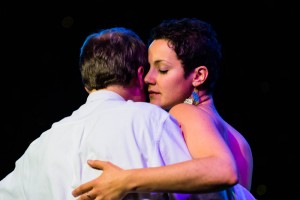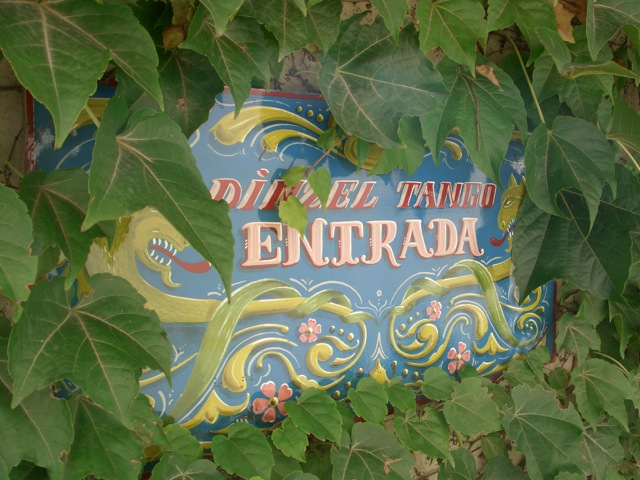Gabriela Condrea is a Tango dancer and instructor, world traveler and author of the book “When 1+1=1: That ‘Impossible’ Connection.” She is in the Bay Area this weekend offering a few unique Tango workshops . Gabriela hails from Seattle, Washington and prior to Tango was an 8th grade teacher. A year sabbatical in South America became a life transforming experience. Here at SF Loves Tango we love to hear how Tango changed people’s life’s. Gabriela’s visit to the Bay Area seemed like a great opportunity to learn more about her with an SF Loves Tango interview.
 SF Loves Tango: Welcome back to the Bay Area. How long will you be here and what do you have planned?
SF Loves Tango: Welcome back to the Bay Area. How long will you be here and what do you have planned?
Gabriela: Thank you. I’ve been lucky to meet so many wonderful people who have taken an interest in my writing and tango projects and really made me feel welcome in the Bay Area.
I’ll be here September 20th to the 22nd and have quite the line-up of events coming up: an interactive book presentation (When 1+1=1), tango workshops to share tools for developing presence and connection in walking, ochos, and (so very tango) the cross, visiting with Ivan Shvarts during his class in Emeryville and talking to him about “liver tango,” and last, but not least, I’m so excited to be collaborating with local Oakland author and tanguera Sasha Cagen, offering a workshop on tango and personal growth.
Here is the schedule:
Friday 9/20: Guest Teacher at Release Tango Friday
Saturday 9/21: Tango Workshops (Connection & the Cross!) at Studio 1924
Interactive Book Presentation at Café Mediterraneum FREE!
Sunday 9/22: QuirkyConnection Tango Workshop w/ Sasha Cagen
Details at www.GabrielaCondrea.com/tango/events/Bay_9-2013.html
SF Loves Tango: You have been doing a lot of traveling since your book was published, can you describe a few of your most memorable travel experiences.
Gabriela: I have many travel stories and tango stories… How about I give you a little of each?
Traveling with the book as a catalyst/excuse has been amazing. So many people have pitched in to make it possible! Having the book, my blog, and upcoming series of video interviews from the road really opened up some great opportunities to connect with people. One of my favorite things has been hearing peoples’ stories. Everything from how Matt of Fat Matt’s Rib Shack in Atlanta got his start, how they developed their secret sauce (no, he didn’t give me the recipe), the strong bonds with his employees who are more like family; or the tour guide from the Florida Everglades at Coopertown Air Boat Tours who told me that this – he said, sweeping his arm across the landscape – has been healing for him after coming home from the army. The stories are many and many of them quite amazing. I think the most amazing part is realizing that although they’re all so different and unique, they’re also very similar themes that we all encounter in our lives, and on the dance floor: this amazing network of tango aficionados is like having a family everywhere you go. Especially when I reach out, someone is always there to help.
During my first book tour to Europe, I visited a friend in Bonn, Germany. She lent me her bike and I made my way to a tango event where I met Ulrike, who assured me that the tango community will never leave you without a place to stay: Just bring a sleeping bag and you’ll never not have a place to stay in the tango community, she said. Then there was the man I met at the Ukrainian in New York, who told me that tango has been therapeutic for him – a new kind of drug. And although I’ve been lucky to never struggle with substance abuse problems myself, I could understand him. I’ve learned that remembering just how similar we are can really help us empathize with one another and celebrate our differences.
SF Loves Tango: I read that you first learned Tango at Dinzel’s Tango studio in Buenos Aires. I took a private lesson with Rodolfo Dinzel and it was by far one of my most memorable experiences in Buenos Aires. He told my partner to imagine himself as a river, continuous and flowing and for me to imagine myself as a bird playfully flying along with the river. This visualization was transformative for our dance. Did you have a similar experience with Dinzel? Can you describe for us what it felt like to learn Tango at Dinzel’s studio?
Gabriela: Learning tango at the Dinzel Studio was one of the best things that happened to me. It completely fit my learning style and changed my vision of what is possible. At the Dinzel Studio, you learn by doing. There are classes, but as Rodolfo Dinzel once told me, “If they’re walking, let them walk.” The emphasis is on learning by experimenting and exploring, through trial and fire and bouncing off the white stucco walls of the square rooms of this little house so many people come to call home. I was fortunate to study closely with Rodolfo, taking his seminars and observing his teaching. He uses many metaphors like the one you mention above, to help people reach a deeper, emotional level. Bits of his wisdom, his vivid analogies, the way he plays with subtleties and nuances, are scattered throughout When 1+1=1. Rodolfo taught me so much more than how to dance tango; he sees deeply, he gives openly. Perhaps most importantly, he helped me understand that learning is an active process, that if you want something, you have to go out and get it, that intelligence is knowing how to choose.
SF Loves Tango: Having been a teacher in the past, how has that helped you in teaching Tango?
Gabriela: I’ve taught in some form or another since I was 13 years old and began assisting with swimming lessons after swim team practice in the summer. At 14, I was training to teach gymnastics so that on my 15th birthday (the legal age to work), I could start teaching on my own. My mother is a teacher and both of her parents were teachers. I used to sit in my mother’s language classes, watching her, how she interacted with her students, how they interacted with one another. Her approach to teaching languages has greatly shaped my approach to studying and teaching spoken languages and the way I share (teach) the physical language of tango. And of course, Rodolfo Dinzel and many other teachers influenced me a great deal. I think we remember the most passionate ones – the people most passionate about what they’re sharing.
When I was teaching at Asa Mercer Middle School in Seattle, I had a co-worker, Martin. Martin could make the most lifeless Power Point slideshow breathe. When he talked, everyone listened. He hooked you with his wit and reeled you in with his smile, and before you knew it, you’d sail right through what could have been one of the longest half hours of your life! His students loved him. His classes were a hit. I wanted to do that, too. I wanted to be that way with my students. But I couldn’t do it – no me salía. I could admire Martin, but I couldn’t be someone I’m not. Learning tango and teaching tango have been that way, too. I’ve found lots of great examples of people I want to emulate – on the dance floor, in their classes – and I’ve encountered some examples I want to make sure I don’t replicate. Teaching has taught me to gather all those ideas and find my own way of expressing them, my own way of organizing them. And the many years of teaching have given me the confidence and the freedom to follow my intuition and improvise.
SF Loves Tango: We should all be wise enough to follow our intuition and improvise… in life and Tango. Thank you Gabriela for sharing your stories with us!
Would you like to read her book? Here you go: